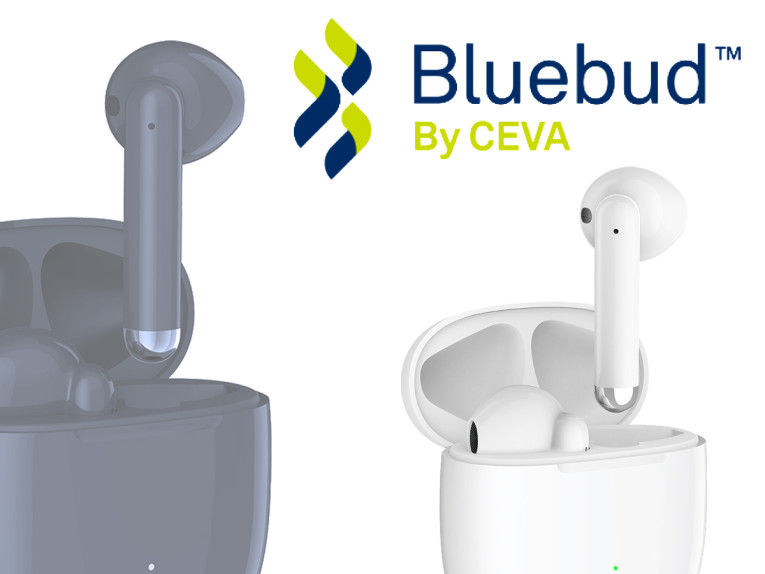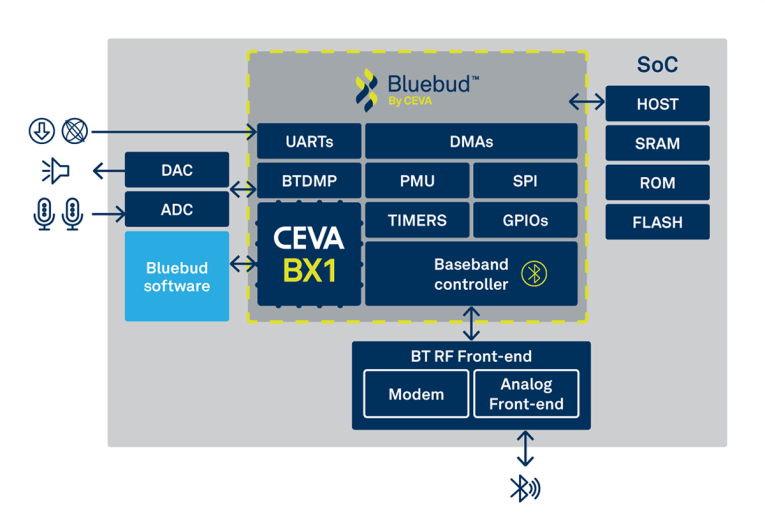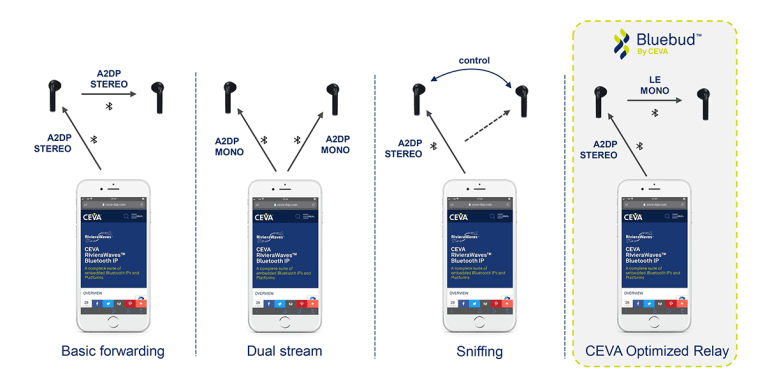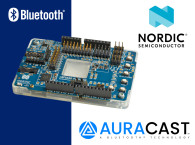
As an integrated hardware and software IP platform, Bluebud aims to solve the technology complexities of combining audio with Bluetooth, providing a drop-in solution for semiconductors and system companies targeting the fast-growing wireless audio market. CEVA designed Bluebud as a turnkey hardware and software platform that is particularly well suited to support developers and brands in dealing with TWS earbuds, a fast-growing but increasingly competitive space.
Bluebud offers advanced, value-add software and toolkits optimized for the onboard CEVA-BX1 DSP, including audio codecs, voice assistants, spatial audio, in-ear detection, tap control, activity classification and full support for TensorFlow Lite Micro machine learning models.
The platform helps developers solving for good the current challenges of bad Bluetooth link quality, poor audio quality, unstable left/right synchronization, short battery life (including one earbud dying before the other), or limited user interface. CEVA's complete and feature-rich Bluetooth Audio hardware and software IP platform helps manufacturers bring to market differentiated TWS earbuds and other wireless audio devices with state of the art performance.
And expanding on the huge savings in TWS and application software development effort, CEVA complements Bluebud with all the tools needed for further design differentiation. This includes, CEVA add-on software extensions, the possibility of adding developer-specific software extensions, and on-demand customization services.

The Bluetooth audio market growth is expected to accelerate in the coming years. CEVA's Bluebud addresses the technology complexities and scarcity of expertise that semiconductor and system companies are facing for the development of wireless audio systems. The platform serves to provide a standardized and self-contained solution that companies targeting the lucrative Bluetooth audio market can effectively drop-in to their system-on-chip (SoC) design, dramatically reducing the high entry barriers and time-to-market.
The platform combines CEVA’s RivieraWaves Bluetooth 5.2 IP, with both Classic Audio and LE Audio, and the CEVA-BX1 audio processor, together with all the required peripherals for wireless audio, in a compact low power design, with a footprint of less than 0.5mm2 in 22nm. The single-core architecture reduces the overall latency from RF to audio output down to less than 20ms, ensuring impeccable audio/video sync for movies and gaming. The design also incorporates an advanced power management unit supporting idle and sleep power-down modes through sophisticated clock and voltage scaling, inherent in the fully integrated Bluetooth audio platform.
Furthermore, the onboard CEVA-BX1 DSP along with the SenslinQ DSP software framework enables semiconductor and OEM users to seamlessly integrate differentiated, value-add software from CEVA, its ecosystem partners or custom software, onto the Bluebud platform. CEVA’s optional software available for Bluebud includes ClearVox multi-microphone noise reduction & acoustic echo cancellation, WhisPro voice trigger & commands, and MotionEngine Hear for user control via tap and double tap, head tracking, in-ear detection and activity classification. For lite AI inferencing workloads, Bluebud allows users to run TinyML models such as a wake word engine to summon your voice assistant or detect sound events for contextual awareness, using native support for the TensorFlow Lite Micro neural network framework.
"Consumer demand for TWS earbuds and other wireless audio devices has grown tremendously, with more diverse use cases and new features consistently being introduced," says Erez Bar-Niv, CTO of CEVA. "The Bluebud platform serves to standardize DSP-enabled Bluetooth audio IP for any semiconductor or systems company, solving the complex challenges of syncing audio packets over Bluetooth, with a drop-in IP that delivers robust, high quality Bluetooth connectivity and audio performance. Supported by our portfolio of audio, voice, sensor fusion and AI software, Bluebud customers can develop differentiated wireless audio solutions with outstanding performance, addressing the full range of tiers from budget through to premium experience, faster than ever."

Since its debut, Bluetooth 5.2 and its integral LE Audio has transformed Bluetooth audio thanks to new features that enhance audio quality and link robustness as well as enabling new audio sharing use cases. The audio quality improvements are courtesy of the LC3 codec, optimized for the CEVA-BX1, which also enables lower power operation and so extending the battery life of TWS earbuds and other audio streaming devices.
The CEVA-BX1 processor combines efficient DSP compute capability with high-level programming and compact code size requirements of embedded applications. Using an 11-stage pipeline and 4-way VLIW micro-architecture, it offers parallel processing with a Single Instruction Multiple Data (SIMD) ISA, widely used in neural networks inference, noise reduction and echo cancellation, as well as high accuracy sensor fusion algorithms.
The CEVA-BX1 chip is accompanied by a comprehensive software development tool chain, including an advanced LLVM compiler, Eclipse based debugger, DSP and neural network compute libraries, neural network frameworks support in the form of TensorFlow Lite Micro, and choice of industry leading Real Time Operating Systems (RTOS).

Supporting Developers
Detailing the system's approach, CEVA's Bluebud platform features a single core CEVA-BX1 processor for DSP and control, simplifying the SoC architecture compared with multiple cores that are required to build similar systems. While offering a self-contained approach where everything from Bluetooth link control, host protocol stack, profiles and audio codecs, up to the application can run on the embedded CEVA-BX1, Bluebud also provides the SoC integrator the option to add a host CPU to run user applications.
On the Bluetooth audio side, Bluebud offers support for Bluetooth 5.2 with both Classic Audio and LE Audio, and the solution is software upgradeable to the next Bluetooth version. This allows developers to complete projects with support for the Classic Audio software stack, required for Bluetooth audio streaming, with A2DP profile for music streaming, including SBC, AAC and MP3 codec support, and HFP profile for voice calls, including CVSD and mSBC codecs. But new designs will be able to expand also with the complete LE Audio software stack, for audio streaming over Bluetooth low energy, with new audio profiles for voice call and music streaming, including LC3 codec support. This complete toolset will also help dealing with easy and fast Bluetooth pairing with multi-source support, allowing buds to be connected to several devices and instantly switch between them when required.
Ahead of its public announcement, audioXpress spoke with Franz Dugand, Sales and Marketing Director, Wireless IoT BU at CEVA, Inc, about this solution, and we learned that Bluebud also offers a new and exclusive approach to the always challenging requirements of true wireless stereo connectivity. This typically involves dealing with left/right synchronization, latency, and more tightly controlled left/right audio jitter, along with the need to support seamless bud-to-bud role-switching to maximize battery life.
To address these challenges, the Bluebud software framework combines an integrated Bluetooth 5.2 dual stream mode with a unique CEVA Optimized Relay solution. Together these modes address the "one source, two sinks" problems that have always affected Bluetooth true wireless designs and are not natively supported by the Bluetooth Classic standard. The Bluetooth SIG has addressed this in LE Audio by implementing a natively supported true wireless mode with dual stream, which is excellent and very efficient, but will require Bluetooth LE 5.2 support on the source side. The CEVA Optimized Relay implementation also works with Bluetooth Classic (BR/EDR) source devices, and offers a connection from one earbud to the other, similar in nature to the "sniffing" approach used by Apple and other manufacturers (see figure below), with excellent stability, tight left/right synchronization (5µs) and very similar battery life efficiency. This will help manufacturers better support all Bluetooth source devices, existing and future, with their new designs.

With its flexible architecture, the Bluebud platform will also allow a high level of software customization, with easy addition of customer/partner software add-ons thanks to the mentioned SenslinQ framework and plug-ins, while CEVA's own software solutions offer support for voice front end processing and speech recognition, and plenty of options for sensors, biometrics, head-tracking, spatial audio and other advanced implementations.
The CEVA Bluebud platform is available for licensing by end of Q1 2021.
www.ceva-dsp.com/product/ceva-bluebud/







